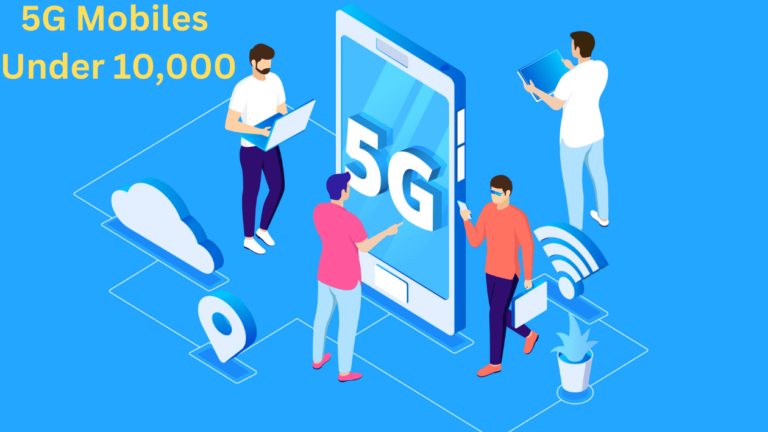Exploring the Prospects of 5G Mobiles Under 10,000 INR

An Overview of 5G
5G mobiles under 10,000 INR, A 5G SIM is a tamper-proof security element and the only way to provide secure 5G network access. The 5G standardization authority ETSI-3GPP defines it in Releases 15 and 16 of the UICC standards (UICC: Universal Integrated Circuit Card, often known as SIM).
5G is the most recent wireless technology standard that operates as a network. Still, it is more than just a speedier variant of 4G; it marks an important change in the way we think about wireless networks.
The procedure of establishing a 5G network involves cooperation among authorities and telecommunications firms.
5G is a networking technology that will enable extremely fast and contemporary internet rates.
Discovering 5G mobiles under 10,000 INR may be difficult. However, costs might change owing to market conditions and technological improvements, so it is important to check recent offerings and bargains.
Further are a few common recommendations for obtaining affordable 5G mobiles under 10,000 INR.
What is 5G?
5G is the fifth-generation mobile network. It refers to a new worldwide wireless standard that follows 1G, 2G, 3G, and 4G networks. 5G allows an innovative kind of connection that has been designed to link almost everyone and everything, including machines, objects, and gadgets.
5G wireless technology is designed to provide more users with better multi-Gbps peak data rates, super low latency, greater dependability, huge network capacity, enhanced availability, and a more consistent user experience. Improved efficiency and effectiveness provide novel experiences for users and links emerging sectors.
History of 5G
5G rollout began in 2018, with certain nations moving fast to phase out 4G in favor of 5G. South Korea became the first country to widely use the network.
Large areas of the United States currently support 5G. These figures are projected to increase as more 5G infrastructure is installed.
Invention of 5G in Brief
o No firm or person owns 5G, but several businesses in the mobile sector are working towards bringing it to daily life. Qualcomm served a significant role in developing several essential technologies that propel the sector ahead and comprise 5G, the next wireless standard.
o We are at the center of the third-generation partnerships project (3GPP), an industry group that develops worldwide specifications for 3G UMTS (including HSPA), 4G LTE, and 5G technology.
o 3GPP is pushing several important innovations in all parts of 5G architecture, from the air interface to the service layer. Other 3GPP 5G members include infrastructural suppliers, component/device makers, cellular network administrators, and vertical service providers.
Some Facts About 5G
- 5G, like many earlier telecommunications advances, has sparked a slew of conspiracy theories. These conspiracy theories link 5G deployment to several diseases, including COVID-19 and cancer. Such conspiratorial ideas, as most others, are unfounded.
- The network for 5G is fast expanding, with certain estimates estimating that 1.5 billion people will have access to it by 2024.
- 5G towers may be added to current 4G networks, reducing infrastructure costs.
- The rollout of 5G technology will provide an important boost to a variety of industries, including mobile gaming, automation, consumer goods, and production.
- 5G can significantly improve both augmented and virtual reality by fundamentally changing how people connect to the internet.
The Distinction Between Previous Generations of Mobile Networks and 5G?
1G, 2G, 3G, and 4G.
- In the 1980s, the initial generation to use 1G technology provided analog speech.
- Second generation: 2G
- In the early 1990s, 2G brought digital voice (for example, CDMA).
- Third generation (3G)
- Early 2000s: 3G introduced mobile data (e.g., CDMA2000).
- Fourth generation (4G LTE)
- 2010s: 4G LTE ushers in the era of mobile broadband.
- 1G, 2G, 3G, and 4G all contributed to 5G, which is intended to give greater connection than ever before.
- 5G is a streamlined and more capable air interface. It has been proposed to use greater storage capacity to support next-generation user encounters, new installation patterns, and fresh offerings.
With its fast speeds, greater dependability, and low latency, 5G will propel the mobile ecosystem into new territory. 5G will influence every business, enabling safer transportation, remote healthcare, precise agricultural sector, computerized logistics, etc.
About Different Uses of 5G
Broadly speaking, 5G is employed in three sorts of linked services: improved mobile broadband, mission-critical communications, and enormous IoT. One distinguishing feature of 5G is its potential to enable future services that do not yet exist.
Improved Mobile Broadband.
Along with improving our devices, 5G connectivity can bring in a fresh immersive experience like VR and AR by enabling faster, more consistent data rates, lower latency, and cheaper cost-per-bit.
5G technology can alter businesses by providing ultra-reliable, low-latency networks for remote management of key facilities, automobiles, and healthcare facilities.
Massive IoT
5G is intended to effortlessly integrate a vast number of embedded sensors in almost everything with the capacity to scale down data rates, power, and mobility—providing very slim and low- Cost-effective connection options.
Speed of 5G Technology
5G, however, is about more than simply speed. In addition to increased peak data speeds, 5G is intended to provide much greater network capacity by extending into an additional spectrum, such as mm-Wave.
5G may also provide considerably reduced latency for a faster response and an overall more uniform user experience, ensuring that data speeds remain constantly high—even when users move around. Furthermore, the new 5G NR mobile network is supported by a Gigabit LTE coverage base, allowing for ubiquitous Gigabit-class connection.
Effect of 5G on Home Internet Service
By replacing current lines with a wireless modem, 5G has the potential to transform household internet service. Internet Service Providers (ISPs) may now serve consumers with 5G infrastructure, making 5G’s coverage, performance, and deployment flexibility a viable backhaul option to fiber, DSL, and cabled solutions.
Cons of Using 5G in Our Day-to-Day Life
Additional 5G towers and infrastructure for networks must be deployed for 5G to function properly. This will be costly and worsen pre-existing internet equity concerns. Furthermore, a gadget that does not support 5G must be updated or replaced. This might be pricey for the typical customer or corporation.
5g Mobiles Under 10000: Name And Details
Below is the list of 5G mobiles under 10,000 INR:
Lava Blaze 5G:
Pros: Clean Android experience, 50MP primary camera, expandable Memory up to 7GB, and glass top style.
Cons: The MediaTek Immensity 700 CPU may not be the quickest, and its appearance is a little thick.
IQOO Z6 Lite 5G:
Pros: Powerful Snapdragon 695 chipset, huge 6.58-inch show, 50MP dual back camera, and rapid 18W charging.
Cons: There are no specialized 5G plans available now, and the Fun Touch OS might not be suitable for everybody.
POCO M4/5G:
Pros: Reliable MediaTek Immensity 700, 5000mAh battery, dual stereo speakers, and excellent workmanship.
Cons: The MIUI UI may contain clutter, and the 6.58-inch display has just a frequency of 90 refresh rate.
These were a few recommendations regarding 5G mobiles under 10,000 INR.
Additional Aspects to Consider:
System Area of Coverage: Determine which 5G networks you have access to and which phones support suitable bands.
Software updates: Look for phones that have a history of getting frequent upgrades.
Company choice: Select a brand that you know provides outstanding client service and afterward assistance.
Conclusion
In short, (5G) network design is a highly complex and advanced structure that combines contemporary innovations such as edge computing and network slicers to provide high-speed, low-latency, and extremely dependable connectivity for a wide range of software as well as services.
Finally, the best 5G mobiles under 10,000 INR are chosen by your specific requirements and tastes. Consider the aspects listed above and compare each phone’s features to make an informed selection.
FAQs
Ø Is it necessary to get a new phone if I want 5G?
o If someone desires to access the connection, it’s necessary to get a new smartphone that supports 5G. Devices that run the Snapdragon 5G Mobile Platforms, for instance, are 5G capable.
As the 5G deployment schedule advances, more smartphones and carrier subscriptions will become accessible as 5G networks and 5G-compatible gadgets grow more prevalent.
Ø Where to find out more about 5G and how it works?
o The Qualcomm® Wireless Academy (QWA) provides a diverse range of 5G training programs for experienced wireless engineers, non-engineers new to 5G, and everyone in between. Programs are available in a flexible eLearning format, allowing you to learn at your speed as well as at any location around the globe.
Ø How does it work?
o Unlike 4G LTE, 5G is OFDM-based (Orthogonal frequency-division multiplexing) & will utilize the same networking concepts. However, the new 5G NR (New Radio) air interface will significantly improve OFDM’s flexibility and scalability.
o 5G will not only provide faster, higher-quality mobile broadband services than 4G LTE, but it will also expand into new service sectors such as mission-critical communications and linking the vast IoT.
Ø Can 4G be turned to 5G?
o It’s completely impossible to perform. To enable the new 5G network, a phone’s technological infrastructure must undergo considerable upgrades, particularly new radio frequency components, and antennas.



Leave a Comment